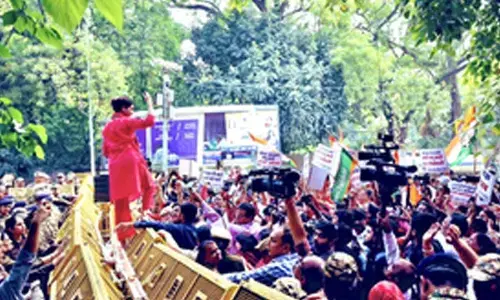Hindustan Aeronautics Ltd must scale up if Tejas are to be saved

If the recent induction of the indigenous Tejas Light Combat Aircraft (LCA) has received a muted welcome from the IAF, there are very good reasons for it. While the nation and the defence-industrial complex may celebrate a milestone in military indigenisation, the service, charged with the defence of our skies, has much more to worry about.
Given the historical inability of our public sector to reform itself, Navy and Air Force should urge the government to form multiple public-private joint ventures involving ADA, divisions of HAL, the Indian private sector and foreign aerospace companies
- Obsolescence is eroding the IAF aircraft strength
- Rafale deal is in limbo, no inductions from abroad on the horizon.
- The IAF may have to make do with the Tejas and its future derivatives
- Low production rates and other negative factors confront HAL
- Navy like IAF would need a medium fighter like Rafale
If the recent induction of the indigenous Tejas Light Combat Aircraft (LCA) has received a muted welcome from the IAF, there are very good reasons for it. While the nation and the defence-industrial complex may celebrate a milestone in military indigenisation, the service, charged with the defence of our skies, has much more to worry about.
With obsolescence eroding its aircraft strength and the Rafale deal in limbo, there seem to be no inductions from abroad on the horizon; other than a few more Sukhoi SU-30s to attain the target strength of 272 heavy fighters. The IAF, while still seeking a medium fighter, may have to make do with the Tejas (and its future derivatives) in terms of numbers as well as capability till something else turns up.
Since much of the IAF's combat fleet is assembled, overhauled and supported in-country, this would make the service totally dependent on India's monolithic aerospace giant: Hindustan Aeronautics Ltd (HAL).
This is a thought that would strike dread in the heart of any air warrior. Having flown many HAL products and been associated with its aircraft and helicopter projects, I can put my fingers on (at least) four good reasons for the IAF's leadership to be apprehensive in this regard. Most of them are attributable to HAL's public-sector work-ethos, nurtured by a protective Department of Defence Production.
First, the lackadaisical approach of HAL's unionised employees that engenders low productivity. Secondly, poor production-engineering standards that create maintenance and inter-changeability problems on aircraft. Thirdly, the high failure rate of HAL manufactured components and systems with attendant safety implications. Lastly, sub-optimal product-support that frequently leaves HAL customers high and dry without any options.
Given the acceptance of Tejas by the IAF whether voluntarily or under duress this aircraft now assumes a key role in India's national security matrix. It must, therefore, not only be inducted in sufficient numbers in a compressed time-frame but also be accorded Final Operational Clearance at the earliest, to enable combat exploitation over its full envelope.
Concurrently, improvements, upgrades and modifications have to be wrought in the Tejas to enhance its capabilities. Given low production rates and the other attributes of HAL, mentioned above, all this is unlikely to happen unless the Ministry of Defence (MoD) thinks out of the box, adopts an innovative approach and acts with alacrity.
Going by past precedent, it would be unrealistic to expect the MoD to undergo an overnight transformation in outlook and it would, therefore, have to be the end-users who must provide the initial impetus and sustain momentum of desired changes. At this juncture, a digression is necessary to highlight the Indian Navy's interest in the LCA and to illustrate the critical importance of customer involvement in project management.
Unbeknownst to many, the Indian Navy, in keeping with its commitment to indigenisation, has been a steadfast supporter of the LCA for decades. In its quest for a ship-borne version of the aircraft, the Navy commenced discussions with the LCA's designer, the Aeronautical Development Agency (ADA), in the early 1990s.
The prototype LCA (Navy) was rolled out in July 2010, and has been undergoing trials on a specially constructed carrier simulation facility at the naval air station in Goa. With three aircraft-carriers projected in its plans, the Navy would need 100-150 ship-borne fighters in the next two decades. While the LCA (Navy) if successful would make up some of these numbers, the Navy (like the IAF) would also need a medium fighter to equip its carriers, but one which is carrier-compatible for catapult-launch and arrester-hook recovery.
Currently there happen to be three such examples in the market the US F/A-18 Hornet and F-35C Lightning II and the French Rafale. Given the historical inability of our public sector to reform itself, the two services should urge the government to form multiple public-private joint ventures (JV) involving ADA, divisions of HAL, the Indian private sector and foreign aerospace companies.
These initiatives, which will not only transform India's aerospace industry but also bolster national security, must include joint ventures for: (a) the modernisation and streamlining of HAL's existing production facilities; (b) creation of additional assembly lines to boost LCA production rate; (c) exploring, with ADA, upgradation of the LCA and design of LCA Mark II; and (d) setting up a new aero-engine production plant for the LCA.
Should the IAF and the Navy be able to agree upon a common medium fighter, they would have a powerful lever to persuade the government to set up another JV for its collaborative production in India. (Admiral Arun Prakash is a former Indian Navy chief)
By Admiral (Retd) Arun Prakash




















